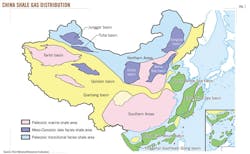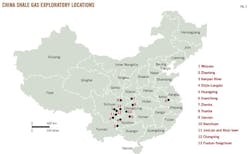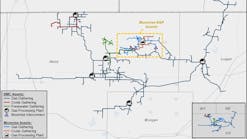China vigorously promoting shale gas exploration, development
Guo Jian-chun
Zhao Zhi-hong
Southwest Petroleum University
Chengdu City
Shale gas exploration and exploitation in China is still at an early stage.
Natural gas accounted for 4% of China's total energy consumption in 2010. The natural gas share of total world energy demand was nearly six times that, according to the BP Statistical Review of World Energy 2011.
In the first 5 months of 2011, Chinese crude oil import dependence reached 55.2%, according to the Ministry of Industry and Information Technology.
China's shale gas resource is 100 trillion cu m, and the technically recoverable shale gas resource is 36 trillion cu m.1
Shale gas in China
Here are key dates and activities in the progression of shale gas exploration and exploitation in China.2
Before 2004: Study foreign shale gas exploration technology.
From 2005 to 2007: Shale gas resource exploitation.
In 2008: Exploitation of the Upper Yangtze region and planning shale gas project.
In 2009: Evaluating shale gas resource potential and defining favorable exploration targets in key areas.
In 2010: Carrying out exploitation in the Sichuan, Chongqing, Guizhou, and Hubei shale gas areas; conducting shale gas resource exploitation in the Lower Yangtze Anhui, Zhejiang, and Jiangsu regions; and carrying out preliminary shale gas research in the northern region (north, northeast, and northwest China).
In 2011: Defining areas of probable shale gas reserves in China.
According to the preliminary evaluation in China, the shale gas resource is 21.5-45 billion cu m, mainly distributed in five regions: the south, northwest, north, northeast, and Qinghai-Tibet. The south and the northwest have the most favorable reservoir conditions and are the areas of main concentration (Fig. 1).2
Terrestrial shales underlie 20,000-25,000 sq km, mainly in the Junggar, Tuha, Bohai Bay, Ordos, and Qaidam basins.
Sea-land transition shales underlie 15,000-20,000 sq km in northern China.
Marine shales underlie 60,000-90,000 sq km in southern China, north China, and the Tarim basin.
By October 2011, China has tested or fractured 22 shale oil or gas wells, of which 3 are shale oil wells, 2 are horizontal shale gas wells, and 17 are vertical shale gas wells (Table 1). Among these wells, 10 wells are drilled by Sinopec, 8 wells are drilled by China National Petroleum Co., and 4 wells are drilled by Yanchang Petroleum (Group) Co. Ltd.
Shale oil well production rates are 0.5-4.6 cu m/day, and the maximum shale gas well test production rate is 60,000 cu m/day. The preliminary exploitation and exploration show that Chinese shale oil and gas has bright prospects.
Exploitation and exploration policies
In recent years, the Chinese government has emphasized shale gas exploitation and exploration, takes shale gas as part of the country's new energy strategy, and has set up national science and technology major projects and the state "Twelfth 5-year" energy development plan (2011-15).
In the Twelfth 5-year plan period, in order to support the shale gas exploration, the Chinese National Energy Administration (CNEA) will promote to set up shale gas special funds and study the price mechanism and related financial policy. In this period, the goal of CNEA is to find out the shale gas resource potential and increase efforts to develop shale gas industry policy and standards.3
CNEA is setting up a shale gas laboratory in Langfang, near Beijing, to be sponsored mostly by PetroChina Ltd., and that will become the Chinese national shale gas research center.
A total of 870,000 sq km of shale formations in China has been marked as conforming to the conditions for shale gas production. Most of this designated area has already been claimed by CNPC, Sinopec, and CNOOC.
However, 260,000 sq km is still available for oil and natural gas exploitation and exploration rights. China encourages various commercial companies to carry out shale gas exploration and development and is studying the shale gas price mechanism, special funds, and other policies to promote the development of a shale gas industry.4
The Ministry of Land and Resources (CMLR) has selected 33 advantageous shale gas resource areas and issued five mineral exploration rights to CNPC, Sinopec, and CNOOC.
In late June 2011, China conducted the first round of shale gas exploration competitive bidding and invited six state-owned enterprises to participate in bidding for four blocks of mineral exploration rights. Sinopec and Henan Coal-Bed Methane Co. were the successful bidders.
CMLR will open a second public tender for the sale of shale gas prospecting rights later in 2012. The government is still discussing the possibility of allowing foreign companies to participate in the auctions, but a decision is expected soon and it's possible that several blocks may be opened up for bids from both domestic and foreign companies.5
Overall, China will speed up making laws on managing the shale gas resource, improving technological standards on shale gas exploration and development, introducing of competitive mechanisms fully, perfecting foreign cooperation mode, strengthening supervision, and maintain an orderly and healthy level of shale gas exploration and development.5
CNPC's shale projects
CNPC started shale gas exploration and development in 2006, becoming the first Chinese company to begin work in the sector.
In August 2011, PetroChina set a goal for total production of 1.5 billion cu m/year of shale gas by 2015. CNPC has obtained North Yunnan-Guizhou mineral rights and drilled a shale gas data well in the Sichuan basin in 2009.
From the four most promising blocks in the southern Sichuan-northern Guizhou region named Weiyuan, Changning, Zhaotong, and Fushun-Yongchuan, CNPC has designated Changning and Weiyuan as a national pilot test area (Fig. 2). In these areas, 11 appraisal wells have been drilled, four of which produce gas.6
CNPC Southwest Oil & Gas Field Co. plans to build Weiyuan gas field as the national first shale gas development experimental field. It completed five shale gas exploration test wells by September 2011. China's first horizontal shale gas well, the Wei 201-H1 well in Weiyuan gas field, has been stage-fractured (Fig. 2).
CNPC Southwest Oil & Gas Field Co. strives to achieve Sichuan basin shale gas large-scale development by 2015 and hopes to produce 1 billion cu m/year of shale gas in 2015 from the Sichuan basin.
After 2 years of exploitation, CNPC Zhejiang Oilfield Co. has found North Yunnan-Guizhou shale gas formations, discovered a preliminary shale gas resource of 600 billion cu m in the Muai town experiments district where the high quality shale gas resource is 140 billion cu m, and has chosen the JunLian area as a shale gas demonstration area (Fig. 2).
Sinopec's shale gas activity
Sinopec started shale gas exploration and development in 2008 when it established the Department of Shale Gas Exploration Project Management.
Sinopec started evaluating potential shale gas resource projects in Southern District exploration blocks, identifying the shale pay layers in the Yuanba region and researching the shale gas geological conditions in Nanpan River, Zhenba area.7
Sinopec won Nanchuan shale gas block exploration rights in July 2011, when it promised to invest $90.8 million in exploration for 11 stratigraphic and exploratory wells. Sinopec has selected the Jiannan and Huangping blocks among northern Chongqing, southern Anhui, northeast Sichuan regions (Fig. 2), and has drilled five evaluation wells. Two vertical wells produced gas.
Sinopec Exploration South Branch in April 2011 launched the project of southern area shale gas resource potential and block evaluation, has selected and tested old wells in the Sichuan basin, and has ascertained an area favorable for shale gas exploration in the basin.
Sinopec Exploration South Branch strives to achieve the south shale gas exploration area breakthrough in 2-3 years and to achieve commercial production in 3-5 years.
Sinopec Jianghan Oilfield started shale gas exploration and development in May 2010. Shale gas resources are rich in the Jianghan exploration area, in which the Middle Yangtze region's Eastern Chongqing west Hubei-West Hubei & Hunan is an area favorable for shale gas exploration.
Jianghan Oilfield has tested five exploration wells and has drilled and staged-fractured the first shale gas horizontal well of Sinopec in September 2011 (Fig. 3). Jianghan Oilfield strives to achieve shale gas annual production of 1 billion cu m/year by the end of the "Twelfth 5-year" period.
Sinopec East Branch specializes in unconventional oil and gas exploration and development. On the basis of strategic assessment, Sinopec East Branch preliminarily selected the Middle Guizhou Province, Xuancheng, Northern Hubei Province, and Zhijin-Langdai as four favorable test blocks (Fig. 2). Sinopec East Branch is working in accordance with the strategic planning of "start 1 year, 2 years of breakthrough, 3 years' production" and strives to increase income from shale gas for Sinopec early.
Yanchang Petroleum (Group) Co. Ltd.
Yanchang Petroleum started shale gas exploration and development in 2009 and has carried out the project of "the unconventional oil and gas resource assessment in Yanchang area."
In 2010, the company took the National major projects of "Shale Gas Efficient Development Demonstration Project in Southeast Ordos Basin," has made great progress, and estimated that the shale gas resource in the Yanchang area of the Ordos basin is 15-18 billion cu m. Two shale gas wells of Liuping-177 have been successfully fractured and produced commercially. Yanchang Petroleum has created a milestone in Chinese terrestrial shale gas development.8
Yanchang Petroleum has drilled 12 exploration wells and evaluation wells, strives to produce 20 million cu m/year of gas by 2012, and aims to produce 500 million cu m/year by 2015.
All other companies
In October 2010, CNOOC paid $2.16 billion for rights to a Texas shale gas project owned by Chesapeake Energy Corp., the second-largest natural gas producer in the US. CNOOC also carried out preliminary investigations in Anhui and Zhejiang in China.9
In 2011, Henan Provincial Coal Seam Gas Development & Utilization Co. (HPCSDUC) was awarded the Xiushan block, near the junction of Hunan, Chongqing, and Hubei provinces, an area of 208,869 sq km. HPCSDUC plans to drill 2 stratigraphic wells and 8 exploration wells, to complete the overall exploration target, and to invest $48.2 million in 3 years.5
Small and private companies are preparing to compete against the Big Three energy giants for shale gas rights.
International cooperation
In 2007, CNPC signed the first external cooperation agreement with Newfield Exploration Co., Houston, on shale gas development. The agreement, "Cooperatively Study Weiyuan Regional Shale Gas," was finished in July 2008.
Since 2009, China and the US began cooperation and carried out all-round cooperation in shale gas resource assessment, exploration, and development. In September 2009, China and the US conducted a special communication on unconventional gas at the Ninth Forum on China-US oil and gas industry.
In November 2009, the CNEA and the US government signed a memorandum of understanding on shale gas cooperation.6 7
In 2009, CNPC and Shell started the project of cooperation exploration and development Fushun-Yongchuan shale gas block and have drilled the Yang-101 well and Zhen-101 well.
In January 2010, Sinopec and BP cooperated to develop a shale gas block in Guizhou.
In March 2010, CNPC and Schlumberger signed a 2010-12 cooperation agreement on logging services.
In April 2011, CNPC and Total SA agreed to invest $2 billion in Inner Mongolia Province to develop unconventional gas.
Summary
The Chinese government, CNPC, Sinopec, CNOOC, Yanchang Petroleum, Henan Provincial Coal Seam Gas Development and Utilization Co., scientific research colleges and universities, nonoil enterprises with abundant funds, and governments at all levels are actively engaged in shale gas exploration and development.
China is actively carrying out cooperation with international oil companies and improving the shale gas exploration and development policies.
China's goal is to attain shale gas recoverable reserves of 600 billion cu m and output of 6.5 billion cu m/year. Chinese total shale gas production rate is to reach 15-30 billion cu m/year by the end of 2020, amounting to 8-12% of Chinese total natural gas production by that time.
Acknowledgment
This article was prepared under auspices of the State Key Laboratory of Oil and Gas Reservoir Geology and Exploitation at Southwest Petroleum University.
References
1. US Energy Information Administration, "World shale gas resources: an initial assessment of 14 regions outside the United States," April 2011.
2. Zhang Dawe, "Speeding up China's shale gas exploration and development and utilization of the main path," Natural Gas Industry, Vol. 31, No. 5, May 2011, pp. 1-5.
3. "Speeding up the shale gas development planning," China Daily, Aug. 16, 2011 (www.chinadaily. com.cn).
4. "China's shale gas development into the industrialization phase will further open the market," China Network Television, July 10, 2011 (news.cntv.cn).
5. Zhou Yan, "The ministry of land and resources years or will for a second shale gas bidding," China Daily, Aug. 31, 2011 (www.chinadaily.com.cn).
6. China Petroleum (www.cnpc.com.cn/cn).
7. China Petrochemical (www.sinopecgroup.com).
8. Shaanxi Yanchang Petroleum (Group) Co. Ltd. (www.sxycpc.com).
9. China National Offshore Oil Co. Ltd. (www.cnooc.com.cn).
The authors
More Oil & Gas Journal Current Issue Articles
More Oil & Gas Journal Archives Issue Articles
View Oil and Gas Articles on PennEnergy.com








